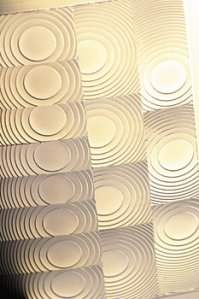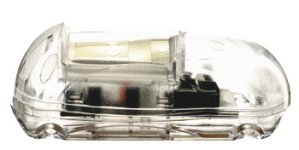
MIGUEL BOYAYANPolymer lenses: the matrix is made from steel molds, engraved using laser beamsPresence sensing electronic sensors used to monitor residential and commercial environments and also in the intelligent control of buildings lightingMIGUEL BOYAYAN
False alarms set off by security systems when they detect an inoffensive cat, for example, instead of the supposed thieves, have their days numbered after the innovation developed by a small company from the town of Sao Carlos. The researchers at Holophotonics have developed small dimension lenses, used in presence sensoring, capable of identifying, with precision, that which is moving within commercial environments and monitored residences. These sensors could also be used to control illumination. They recognize the presence of a person and switch on a light.
The innovative geometry of the lenses invented by the company allows for the sensors to function like an optical filter, blocking, for example, the signal of cats and dogs that circulate in these environments. Only the signal of people is taken into consideration by the system that sets off the alarm in the correct manner. “The sensors that are on the market, the majority imported, make this filtering only during the processing stage of the electronic signal, therefore, posterior to the capture of radiation by the lenses”, advised Giuseppe Antonio Cirino, the company’s research director and the coordinator of the project, which was supported by FAPESP within the modality of the Small Businesses Innovation Research (PIPE) program, which resulted in the product. The security area in Brazil has shown constant growth. Since 1995, it has on average grown 12% per year, according to the Brazilian Association of Electronic Security System Companies (Abese). The number of sensors installed in the country, including those for the presence of smoke, impact, doors and windows, is more than 1 million units.
At the size of a computer mouse, the sensors are placed on the wall, close to the ceiling of the environments whose security is to be controlled. The lenses work in conjunction with a photo-detector, capturing and transforming radiation that the body emits in the form of heat into an electrical signal, which is afterwards processed by an electronic circuit. All of the information remains in the environment of electronic signal processing, since the product does not work with images. The complete system involves from one to around ten sensors, depending on the size of the location being monitored, a central unit that connects to all of them and communicates, via telephone cable or wireless, with the central monitoring unit. “The selling price of our sensor is around R$ 25, whilst the imported ones cost more that R$ 100”, advised director Cirino.
“Various Brazilian companies had attempted to develop the lens, without success”, related director Cirino. Some even arrived at the geometric form of the lenses, but ran up against the development of the appropriate materials, capable of capturing the heat and transferring it to a small detector installed in the internal part of the sensor. “The major difficulty lies in managing to make the optical classification of the material, allowing for it to capture the electromagnetic radiation of a specific wavelength, related to the heat emitted by a person. If this were not to be done, all of the heat is blocked by the lens”, the researcher explained. In the case of the Holophotonics sensor, the micro-lenses are placed within a small milky white plastic rectangle. “We don’t see it from the other side of the material, but for the heat that the sensor captures it’s as if it were transparent glass”, advised director Cirino.
The first step in the manufacturing process of the micro-lenses was to generate a computer model, which afterwards was reproduced in a steel mold, a matrix for the lens production on a large scale. It appears simple, but as it is necessary to embed an optical filter for discerning the silhouettes, the design of the lenses’ geometry has various nuances on the computer that need to be translated into the manufacturing process.

MIGUEL BOYAYANPresence sensing electronic sensors used to monitor residential and commercial environments and also in the intelligent control of buildings lightingMIGUEL BOYAYAN
Patent request
The mold engraving process was carried out using a laser beam by the company LaserTools, of Sao Paulo, which was also born from another FAPESP PIPE project. Two years went by before attaining the mold conceived in the computer project. In the end, the manufacturing system for the micro-lenses resulted in the request for a patent. The Holophotonics company also has partnerships with the Integrated Systems Laboratory of the Polytechnic School, University of Sao Paulo (USP) and with the Electrical Engineering Department of USP’s Engineering School in the town of Sao Carlos.
The research that resulted in the innovative micro-lenses had its beginning with the doctorate thesis written during 1998 by researcher Cirino, at the Polytechnic School of the University of Sao Paulo, related to the manufacture of optical micro-elements. At that time his co-supervisor and today consultant to Holophotonics, was professor Luiz Gonçalves Neto, from USP’s Engineering School at São Carlos, who had returned from Canada where he had carried out his doctorate work on a project along similar research lines. In 2002, after having defended his thesis, Dr. Cirino entered into the PIPE project in partnership with the company PPA, located in the town of Garça, in the interior of Sao Paulo State, which works in the area of door automation, in order to develop new movement detection sensors for applications in domestic and corporate security.
The choice of the PPA company was strategic, because the company has a branch company in electronic security, namely the company Eletroppar. During the project’s development, director Cirino went on to provide service for the PPA company and founded, together with the engineer Robson Barcellos, Holophotonics, initially incubated at the High Technology Park Foundation (ParqTec), of Sao Carlos. After four months in incubation, new partners were incorporated into the company in April of 2005.
The capital sum invested brought to the company a location change to its present headquarters and the development, production and commercialization of a new product line, with the brand name of Qualilux. Among them are the presence sensors directed towards the market of buildings automation and indicated for the control of illumination in internal environments. They can also be placed in house lampshades as a time switch, which puts a circuit on and off at predetermined moments and works like an intelligent electrical energy control. Attending to the electronic security segment is exclusive to the company PPA. The Holophotonics company, as well as the illumination control sensors, still produces wall switches that regulate the environment’s light intensity, known as dimmers, and timer interrupters that automatically switch off after a previously determined time, called minuterias (minute-ers) .
The Project
Development of new infrared movement detection sensors for applications in domestic and corporate security (nº 05/55278-7); Modality Small Business Innovation Research (PIPE) Program; Coordinator Giuseppe Antonio Cirino – Holophotonics; Investment R$ 154,007.28 (FAPESP)